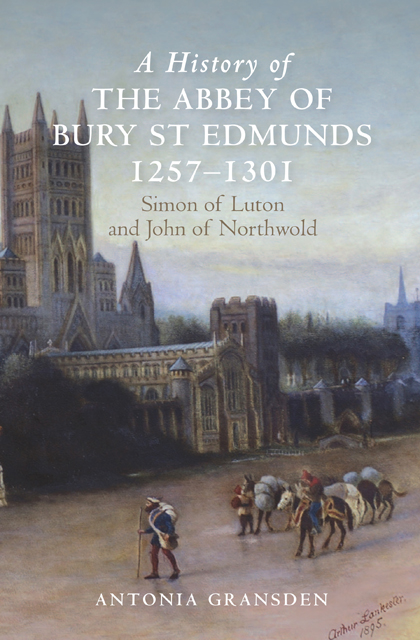Book contents
- Frontmatter
- Dedication
- Contents
- List of plates
- List of figures
- Preface
- Editorial note
- Dedication
- Acknowledgements
- Abbreviations
- Maps and plans (figures 1–11)
- Part I Introduction
- Part II Abbatial Governance
- Part III The Abbey’s Economy
- Part IV Religious Life and Reform
- Part V Intellectual and Cultural Life
- Appendix I The identity of the abbot’s justices, Henry of Guildford and Henry of Shenholt (in 1287)
- Appendix II The monks’ dietary regime: their food and drink
- Select List of the Registers and Customaries Cited
- Select List of Further Manuscripts Cited
- Select Bibliography
- Index
- Backmatter
23 - The Monks as Chroniclers and Historians under Abbot John
Published online by Cambridge University Press: 22 February 2023
- Frontmatter
- Dedication
- Contents
- List of plates
- List of figures
- Preface
- Editorial note
- Dedication
- Acknowledgements
- Abbreviations
- Maps and plans (figures 1–11)
- Part I Introduction
- Part II Abbatial Governance
- Part III The Abbey’s Economy
- Part IV Religious Life and Reform
- Part V Intellectual and Cultural Life
- Appendix I The identity of the abbot’s justices, Henry of Guildford and Henry of Shenholt (in 1287)
- Appendix II The monks’ dietary regime: their food and drink
- Select List of the Registers and Customaries Cited
- Select List of Further Manuscripts Cited
- Select Bibliography
- Index
- Backmatter
Summary
Under Abbot John, so far as is known, St Edmunds produced no scholar of outstanding excellence. Nevertheless, intellectual life flourished in the convent of that time, though how many of the total of eighty or so monks were scholars is impossible to estimate. Evidence for the monks’ studies is provided by the continuations of John Taxster’s chronicle, annotations in the convent’s books, the work-books of individual monks, and by book-acquisitions and production.
The Bury Chronicle is a typical monastic chronicle. Gervase of Canterbury, writing in the late twelfth century, explains the difference between a chronicle and a history:
It is characteristic of a history to tell the truth, to persuade those who read or hear it with gentle words and elegant phrases, and to inform them about the deeds, ways and lives of whoever it truthfully describes; it is essentially a rational study. A chronicle, on the other hand, reckons the years, months and calends from the Incarnation of our Lord; it tells briefly of the deeds of kings and princes which happened at those times, besides recording any portents, miracles and other events.
In practice, the distinction between histories and chronicles became blurred. Chronicles might start as compilations and then, when the author reached his own time, become annals which expanded into narrative. The chronicler might even have literary pretensions and indulge in rhetorical flourishes – a tendency which Gervase deplores: citing Matthew 23: 5, such writers, he says, ‘make broad their phylacteries, and enlarge the borders of their garments’.
The two continuations of Taxster’s chronicle cover the years from almost the end of the annal for 1265 to the beginning of 1296, and from 1296 to 1300. A few desultory and very short annals were added for the years 1301, 1313, 1326, 1329, 1334 and 1335, but in effect the chronicle ends in 1300 (about a year before Abbot John’s death). The first continuation is preceded by a revised version of Taxster’s chronicle.
- Type
- Chapter
- Information
- A History of the Abbey of Bury St Edmunds, 1257-1301Simon of Luton and John of Northwold, pp. 253 - 285Publisher: Boydell & BrewerPrint publication year: 2015

